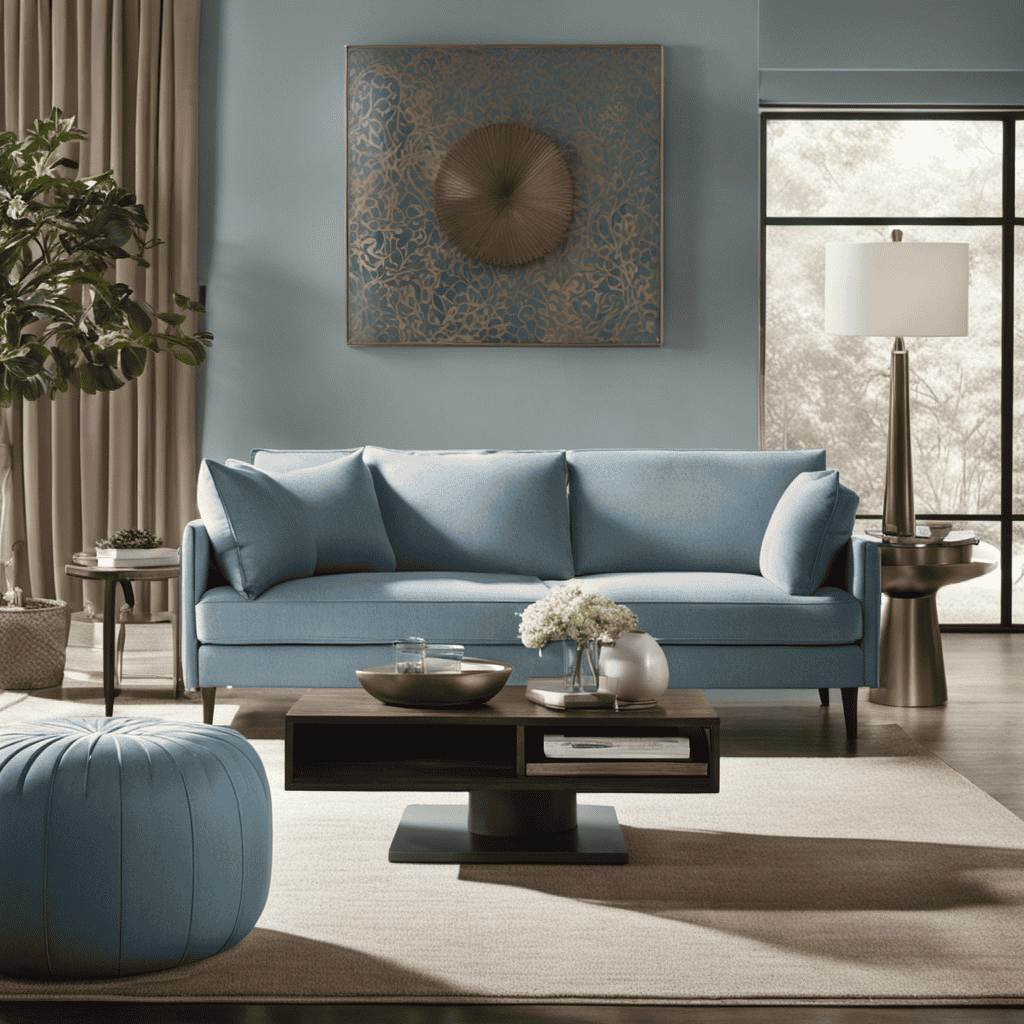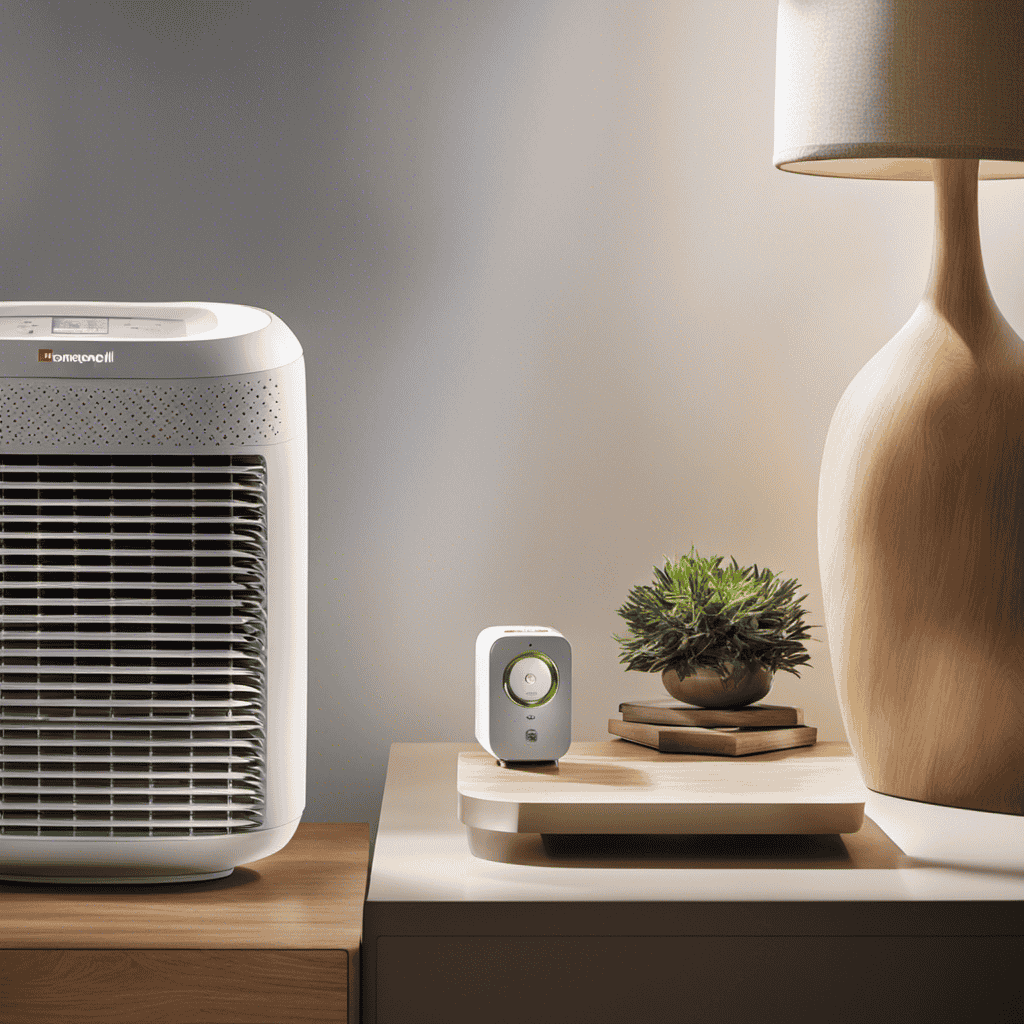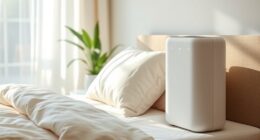As a person who appreciates a restful night’s sleep, I can confirm the advantages of using an air purifier during sleep. It’s truly a breath of fresh air!
In this article, I will share with you the factors to consider when choosing the perfect air purifier for your bedroom, how it improves indoor air quality during sleep, and the best types to enhance your slumber.
Additionally, I’ll provide tips for proper placement and maintenance to create an optimal sleep environment.
Key Takeaways
- Using an air purifier while sleeping can improve air quality, making breathing easier and reducing allergies and allergic reactions.
- Air purifiers can alleviate symptoms like sneezing, coughing, and itchy eyes, as well as reduce congestion, snoring, and breathing problems.
- Air purifiers can enhance sleep quality and overall health by creating a clean and fresh atmosphere, removing fine particles and allergens, and preventing respiratory infections.
- When choosing an air purifier for the bedroom, factors to consider include noise level, room size compatibility, filter replacement frequency, and optimal room placement for proper air circulation.
Benefits of Using an Air Purifier While Sleeping
You’ll experience improved air quality and breathe easier by using an air purifier while you’re sleeping. Not only does an air purifier help to remove harmful particles from the air, but it also has several benefits for your sleep quality and overall health.
One of the key advantages of using an air purifier in your bedroom is its ability to reduce allergies. Air purifiers work by trapping allergens such as dust mites, pet dander, and pollen, preventing them from circulating in the air and triggering allergic reactions. This can greatly alleviate symptoms like sneezing, coughing, and itchy eyes, allowing you to have a more restful sleep.
In addition, the purified air can also reduce congestion, snoring, and other breathing problems, further enhancing your sleep quality. Considering these benefits, it is crucial to choose the right air purifier for your bedroom.
Factors to Consider When Choosing an Air Purifier for Your Bedroom
When selecting an air purifier for your bedroom, there are several important factors to consider.
Firstly, noise level consideration is crucial as you want a purifier that operates quietly and won’t disrupt your sleep.
Secondly, room size compatibility must be taken into account to ensure that the purifier is capable of effectively cleaning the air in your specific bedroom dimensions.
Lastly, filter replacement frequency is a key point to consider in order to maintain optimal air quality and ensure the longevity of your purifier.
Noise Level Consideration
The noise level of an air purifier can greatly affect your sleep quality. When choosing an air purifier for your bedroom, it is important to consider how much noise it produces. Excessive noise can disrupt your sleep and make it difficult to fall asleep or stay asleep throughout the night. To help you select a quiet air purifier, here are some soundproofing solutions to consider:
| Soundproofing Solutions | Impact on Sleep Quality |
|---|---|
| Noise-canceling technology | Minimizes background noise and promotes better sleep |
| Insulated housing | Reduces vibrations and sound transmission |
| Low-speed fan settings | Provides quieter operation during sleep |
Room Size Compatibility
To determine if an air purifier is suitable for your bedroom, consider the size of the room. The effectiveness of an air purifier depends on its ability to circulate and filter the air in a given space. Here are some key factors to consider when determining if an air purifier is compatible with your room size:
-
Room dimensions: Measure the length, width, and height of your bedroom to calculate the square footage. This will help you determine the appropriate air purifier size for optimal performance.
-
Clean air delivery rate (CADR): Look for an air purifier with a CADR that matches or exceeds your room size. The CADR indicates how quickly the purifier can clean the air in a given area.
-
Air changes per hour (ACH): Consider the ACH rating of the air purifier. Ideally, you want an ACH of at least 4 to 6 for maximum effectiveness.
-
Optimal room placement: Place the air purifier in a central location within your bedroom to ensure proper air circulation. Avoid positioning it near walls or furniture that may obstruct airflow.
-
Noise level: Consider the noise level of the air purifier, especially if you are sensitive to sound while sleeping.
Filter Replacement Frequency
By regularly replacing the filters, you can maintain the effectiveness of your air purifier in your bedroom.
The lifespan of air purifier filters varies depending on several factors such as the type of filter, the level of air pollution, and the frequency of usage. Generally, HEPA filters should be replaced every 6 to 12 months, while activated carbon filters may last up to 3 months. It is important to check the manufacturer’s recommendations for your specific model.
When considering the cost of replacement filters, it is essential to compare not only the price but also the filter’s efficiency and durability. Cheaper filters may need to be replaced more frequently, which can add up over time. Investing in high-quality filters might save you money in the long run by providing better air purification and a longer lifespan.
How Air Purifiers Improve Indoor Air Quality During Sleep
Using an air purifier while sleeping can greatly improve indoor air quality. Air purifiers are designed to remove harmful pollutants and allergens from the air, creating a cleaner and healthier environment.
The benefits of using an air purifier during sleep include:
- Reduction of airborne allergens, such as pollen, dust mites, and pet dander.
- Removal of indoor pollutants, like volatile organic compounds (VOCs), smoke, and odors.
- Improvement of respiratory health by filtering out fine particles and allergens that can aggravate asthma and allergies.
- Enhancement of sleep quality by creating a clean and fresh atmosphere, free from irritants that can disrupt sleep.
- Prevention of respiratory infections by eliminating bacteria and viruses that may be present in the air.
By incorporating an air purifier into your sleep routine, you can experience the effectiveness of cleaner and purer air, leading to better sleep and overall well-being.
Now, let’s explore the best types of air purifiers for better sleep.
The Best Types of Air Purifiers for Better Sleep
When it comes to choosing an air purifier for better sleep, there are two key considerations to keep in mind: noise level and filter replacement frequency.
The noise level of an air purifier can greatly impact your sleep quality, so it’s important to choose a model that operates quietly.
Additionally, filter replacement frequency is an important factor to consider as it affects the effectiveness of the purifier in removing pollutants from the air.
Noise Level Considerations
If you’re a light sleeper, you might want to consider the noise level of the air purifier while you sleep. A quiet operation is crucial for minimizing sleep disturbances and ensuring a restful night’s sleep.
When choosing an air purifier, keep these factors in mind:
-
Noise level: Look for air purifiers that have a low decibel rating, typically below 50 dB. This ensures that the purifier won’t disrupt your sleep.
-
Fan speed options: Opt for purifiers with adjustable fan speeds. This allows you to customize the noise level based on your preferences.
-
Sleep mode: Some air purifiers have a dedicated sleep mode that operates at a quieter level during the night.
-
White noise: Consider air purifiers that produce white noise, which can help mask other disruptive sounds and promote better sleep.
-
Placement: Position the air purifier away from your bed to further reduce noise interference.
Filter Replacement Frequency
To keep your air purifier running effectively, make sure to regularly replace the filters according to the manufacturer’s recommended frequency. This is crucial for maintaining the optimal performance of your air purifier and ensuring that it continues to provide you with the numerous benefits it offers.
Air purifiers are designed to remove harmful particles and pollutants from the air, improving indoor air quality and promoting a healthier living environment. The filters play a key role in this process as they capture and trap pollutants such as dust, pollen, pet dander, and smoke.
Over time, these filters become clogged and less efficient, which is why it is important to replace them regularly. By following proper filter replacement frequency, you can ensure that your air purifier continues to effectively purify the air in your home and provide you with clean and fresh indoor air.
Tips for Proper Placement of an Air Purifier in Your Bedroom
Make sure you place your air purifier in a strategic location in your bedroom to maximize its effectiveness. Proper placement is crucial for optimal air purification.
Here are some tips to help you achieve the best results:
- Position the air purifier at least 3 feet away from walls or furniture to allow for proper air circulation.
- Place the unit at a higher elevation, such as on a shelf or dresser, to ensure better airflow and coverage.
- Avoid placing the air purifier near sources of pollutants, such as open windows or doorways, to prevent recontamination of the air.
- Keep the purifier away from direct sunlight or heat sources, as this can affect its performance and lifespan.
- Regularly clean and maintain the air purifier according to the manufacturer’s instructions to ensure optimal functionality.
Common Mistakes to Avoid When Using an Air Purifier at Night
One common mistake people make when using an air purifier at night is forgetting to adjust the fan speed for quieter operation. It’s important to optimize the placement of the air purifier in your bedroom for optimal performance.
Another common mistake is placing the air purifier too far away from the sleeping area. To effectively purify the air, the purifier should be placed within a few feet of the bed.
Additionally, some people make the mistake of not regularly cleaning or replacing the filters, which can lead to reduced efficiency and effectiveness of the purifier.
How to Maintain and Clean Your Air Purifier for Optimal Sleep Environment
Regularly cleaning and maintaining your air purifier is essential for creating an optimal sleep environment. A clean air purifier not only helps remove allergens and pollutants from the air, but it also ensures that the device functions efficiently.
Here are some key steps to maintaining and cleaning your air purifier:
- Replace or clean the filters regularly to maintain their effectiveness.
- Wipe down the exterior of the device with a damp cloth to remove dust and dirt.
- Clean the air intake vents to prevent blockages and improve airflow.
- Check the fan and motor for any signs of wear or damage.
- Follow the manufacturer’s instructions for specific maintenance tasks.
By properly maintaining your air purifier, you can enjoy the many benefits of clean air while sleeping. Improved air quality can help reduce allergies, promote better sleep, and enhance overall wellness.
Can Using an Air Purifier While Sleeping Really Improve My Mental Well-being?
Many experts believe that using an air purifier can indeed improve sleep with air purifiers, and in turn, enhance mental well-being. By filtering out pollutants and allergens from the air, air purifiers create a cleaner, healthier sleeping environment, leading to better sleep quality and overall mental wellness.
Frequently Asked Questions
Can an Air Purifier Completely Eliminate All Allergens and Pollutants From the Bedroom Air?
Yes, an air purifier can effectively eliminate a significant amount of allergens and pollutants from the bedroom air. However, it’s important to note that it may not completely eliminate all of them.
How Long Does It Take for an Air Purifier to Improve the Air Quality in a Bedroom?
Improvement time and air quality effectiveness vary depending on factors like room size and pollutant levels. It’s important to choose an air purifier with a high CADR rating for faster results.
Can an Air Purifier Help Reduce Snoring During Sleep?
Yes, using an air purifier can help reduce snoring during sleep. Air purifier technology filters out airborne particles that can cause nasal congestion and irritation, allowing for better breathing and potentially reducing snoring. The benefits of using an air purifier while sleeping include improved air quality and potentially a quieter night’s rest.
Are There Any Potential Health Risks Associated With Using an Air Purifier While Sleeping?
Using an air purifier while sleeping may have potential side effects. It’s important to consider long-term effects on respiratory health. I once experienced dryness and irritation in my throat due to prolonged exposure to the purifier.
Is It Necessary to Keep the Bedroom Windows Closed When Using an Air Purifier at Night?
It is important to consider bedroom ventilation when using an air purifier at night. Keeping the windows closed can help maximize the effectiveness of the purifier and minimize the introduction of outdoor pollutants. Regular air purifier maintenance is also crucial for optimal performance.
Conclusion
In conclusion, using an air purifier while sleeping can greatly benefit your overall health and well-being.
By choosing the right air purifier for your bedroom and properly placing it, you can improve the quality of the air you breathe during sleep, resulting in a more restful and rejuvenating night’s rest.
Just like a gentle breeze on a warm summer’s day, an air purifier can create a refreshing and revitalizing environment, allowing you to wake up feeling refreshed and ready to take on the day.
So, invest in an air purifier and experience the transformative power of clean air while you sleep.










